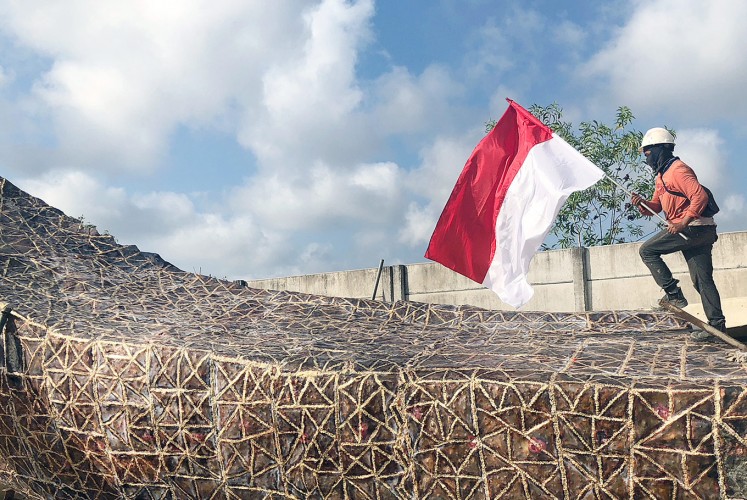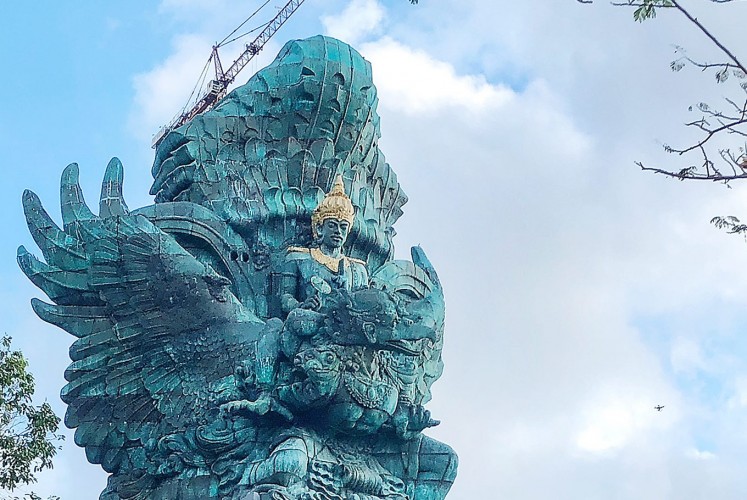With red-and-white flags in their hands, the workers jumped onto the copper and steel structure. Their faces beamed with unbridled joy and soon their chants filled the 4-hectare plot in Ungasan, south Bali, which had served as their adoptive home in the last four years.
“The Garuda Wisnu Kencana [GWK] is complete, [it is time to go] back to Bandung [West Java],” they chanted as they waved the flags proudly.
It was a moment of mixed emotions for the 150 workers from Siluet Nyoman Nuarta (SNN), the company tasked with constructing the country’s tallest statue, the Garuda Wisnu Kencana.
A majority of them hail from Bandung and other regions in West Java. In the last four years, they’ve had to live separately from their loved ones as they assembled the statue’s 754 modules in SNN’s on-site workshop atop a hill in Ungasan.
The statue was crafted at SNN’s main facility in Bandung, but its sheer size made it impossible to transport it to Bali as a single unit. It was separated into 754 modules and transported on flatbeds to the workshop. There, the modules were cut into 1,500 smaller pieces to accommodate the cranes’ maximum load.
The cranes lifted the pieces into their designated spot along the statue’s massive steel inner core. The workers meticulously welded them together, a job that required both mental and physical acuity. Most of the welding jobs took place 100 meters above the ground where wind speeds often reached 10 knots — powerful enough to move a 2-ton module hanging on a crane.

On that historic Tuesday afternoon, the workers danced and chanted on and around the 1,500th piece. Their hearts are filled with pride of having completed a very difficult task and with the joy of realizing they would soon reunite with their families.
“They know they will soon return home to Bandung,” project manager Djuki Ridwan said.
“Now that the statue is finished, I could return to my old job: managing a band,” he joked.
Renowned sculptor Nyoman Nuarta, who designed the statue, watched the workers’ celebration with a smile on his face. There was joy in his eyes and a hint of sadness, too.
“There used to be 1,500 pieces of copper structures there,” he pointed at the now nearly vacant workshop. “Looking at that empty plot gives me a tinge of sadness.”
It was a bittersweet moment, a brief period of melancholy upon realizing the imminent separation from his creation.
The statue had dominated Nuarta’s psyche for 28 years, when he first floated the idea of constructing GWK as a sprawling cultural park with the country’s tallest statue as its centerpiece.
It had been a bumpy ride from the beginning. Local activists decried the plan to build another mega project, while scholars argued that per Hindu cosmology, a statue of Lord Wisnu should be built on the northern point of the island, instead of in the south.

With support from then-tourism minister Joop Ave, energy minister IB Sudjana and Bali governor IB Oka, as well as a presidential nod from the late Soeharto, Nuarta continued the project.
In the late 1990s, the project was brought to a sudden halt by the combining force of the global economic crisis, the fall of Soeharto, internal turf wars between the companies that co-owned the site and lack of committed investors.
The hiatus lasted 16 years until 2013, when property developer PT. Alam Sutera Realty Tbk (ASR) agreed to commit Rp 450 billion (US$40 million) to financing the construction of the statue and the project received other undisclosed sources of funding to develop the cultural park and integrated tourism facility in parts of the 60-hectare site.
The statue itself is made of copper and brass sheeting with stainless steel framework and skeleton. The outer sheeting is 22,000 square meters in size.
An inauguration ceremony on Saturday will be the GWK’s first public appearance after its completion. Some of the island’s well-known artists, including I Ketut Rina and his Cak troupe, as well as singer Ayu Laksmi, will perform during the ceremony.
In its completed form, GWK is 75 m tall with a wingspan of 65 meters. The statue stands on a lofty pedestal that will bring the total height of the monument to 121 m, some 30 m taller than the Statue of Liberty in the United States.

It is the world’s third-tallest statue after the 153-m-tall Spring Temple Buddha in Henan, China, and the 130-m-tall Laykyun Setkyar Standing Buddha in Myanmar.
The GWK weighs 3,000 tons and its volume will be 11 times greater than that of the Statue of Liberty. Despite its sheer size and volume, Nuarta is convinced the statue is safe and would last 100 years.
The design and materials, he stressed, had undergone various integrity tests, including a wind tunnel test that revealed the statue could withstand winds with speeds of up to 259 knots. In Bali, the highest recorded wind speed was 70 knots.
“This is our gift to our nation as we celebrate the 73th anniversary of our Independence Day this month. May this gift remind us all of one of the great pillars of this nation: our cultural legacy and diversity,” Nuarta said before asking his workers to join him in a moment of silence to remember Indonesia’s heroes, past and present.
The mythical Garuda is renowned for its epic struggle to liberate its enslaved mother. This struggle for freedom eventually earned him Amrta, the Elixir of Life.
Source : The Jakarta Post


















